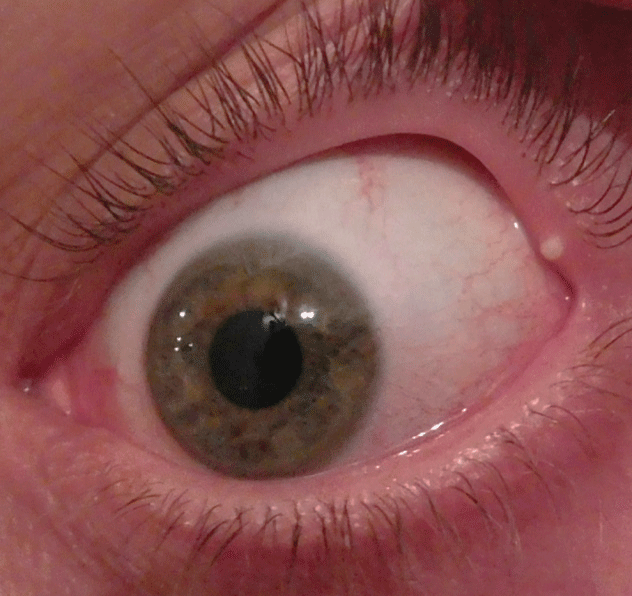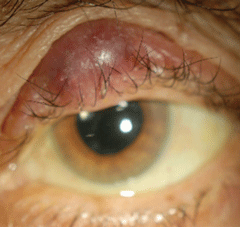 |
Hordeola represent acute bacterial infection and subsequent abscess formation of the eyelid’s sebaceous glands.1-3 Two forms are recognized clinically:
- External hordeola, which involve the more superficial Zeis glands situated at the base of the lashes.
- Internal hordeola, which affect the deeper meibomian glands within the tarsal plate.1-3
 |
An external hordeolum on the left upper eyelid, with classic “pointing” at the lid margin. |
Most often, hordeola present as tender or painful eyelid papules with associated erythema of the involved skin. External hordeola, if large or superficial enough, may demonstrate purulent material within the gland through thinning of the overlying epidermis. When this occurs, the hordeolum is “pointing.” Internal hordeola create a more diffuse eyelid swelling due to the infected gland expanding within the tarsus, although the presentation is still consistent with a firm, tender subcutaneous nodule. Pointing may also be seen with internal hordeola, but because of its deeper location, the lesion must be of substantial size and severity before this occurs. Additionally, internal hordeola pointing can occur at either the skin or conjunctival surface.1
Traditional Therapy
Historically, we were taught that most hordeola are self-limiting, and do not require aggressive therapy. The use of heated compresses, applied for five to 10 minutes several times a day with concurrent digital massage can hasten pointing and subsequent drainage of the abscess. Topical antibiotic ointments may be prescribed for associated blepharitis, but typically will not achieve sufficient concentrations in deeper lid tissue to eliminate the infection; hence, these agents are considered to be of little benefit. We were cautioned against attempting to express or “pop” a hordeolum (unless it was superficial and already pointing). Such vigorous manipulation can be extremely painful for the patient, but more importantly it can potentiate the spread of infection to adjacent glands and tissue, resulting in a more serious preseptal cellulitis. Should secondary chalazia (granulomatous formation within the meibomian gland following resolution of the infectious hordeolum) develop, intralesional corticosteroid injection or surgical incision and curettage can be performed.Reviewing the Literature
In an attempt to gather more unbiased, peer-reviewed and evidence-based information on this topic, we conducted a PubMed search using the term “hordeolum.” Only 26 English-language articles were published in the last 10 years and, of those, only seven were review articles. This paucity of reports on relatively common clinical entities is often the rule, rather than the exception. Many conditions are regarded as so familiar and straightforward that they simply do not warrant much scientific attention in true clinical studies.
To gain additional perspective about the current prevailing attitudes toward hordeolum management, we resorted to referenced works on known medical websites, such as Medscape, EyeWiki, Merck Manual and Family Practice Notebook.4-8 While these sources do not offer the most rigorous scientific evidence, they do provide information regarding expert opinion and practice, presented below.
Conservative Therapies
Most current resources for both internal and external hordeola advise the use of warm or hot compresses in five to 20 minute durations, two to four times daily.4-8 One report recommended concurrent massage of the hordeolum.5 A few sources mentioned daily eyelid and lid margin cleansing for associated blepharitis.5,8 Interestingly, a recent meta-analysis of 944 potentially relevant references found no credible evidence regarding the effectiveness of the aforementioned treatments for acute internal hordeolum.1,3 The authors concluded that, while warm compresses and lid scrubs are not unsafe, they show no measurable benefit as compared with simple observation.3 |
| An internal hordeolum of the upper eyelid in a 75-year-old woman. This patient required a course of oral cephalexin to achieve resolution. |
Medical Treatment
Investigators advocate topical antibiotic ointments for cases of external hordeola, primarily as a prophylactic measure to protect against infection of adjacent glands.1 The majority of medical websites we surveyed also suggest topical antibiotic (or combination antibiotic-corticosteroid) ointment as a potential option, primarily for hordeola that are actively draining.4-6,8However, one source specifically states “topical antibiotics are usually ineffective” in the treatment of internal hordeola.7
All of the websites except one advocated the use of oral antibiotics (e.g., dicloxacillin or erythromycin 250mg PO QID) in recalcitrant cases, recurrent hordeola or in those with suspected preseptal cellulitis.4,5,7,8
Surgical Management
In cases of external hordeola, mechanical epilation of the associated lash follicle may allow spontaneous drainage of the affected gland.1,4 Incision and drainage of acute hordeola is generally not advocated as a first-line therapy; however, it may be advantageous in cases where:- The hordeolum is pointing at the time of initial presentation.
- The hordeolum proves refractory to more conservative medical therapy.1,5,7-10
Incision and drainage of external hordeola may be performed at the slit lamp using topical anesthesia and an 18-gauge or 20-gauge needle.
Incision and drainage of internal hordeola requires a local anesthetic delivered by injection to the involved eyelid. It is customary to employ a stab incision with a #11 blade, ideally using a transconjunctival approach, to avoid potential scarring of the external lid.4,6 A topical antibiotic should be applied to the incision site for 24 hours following the procedure.
We also routinely advocate a course of oral antibiotics if surgical incision and drainage is performed for internal hordeola, as this procedure has the potential to liberate pathogenic bacteria into surrounding tissue and also the bloodstream.
Aged Wisdom
From time to time, it’s important to review and reconsider our therapeutic approaches, even to the most seemingly mundane and straightforward ocular conditions. Medical science often advances faster than we realize, leaving us citing and employing outdated and dogmatic management strategies. Fortunately, in the case of acute hordeola, it would seem that our instinctive philosophies based on 50+ years of combined practice experience aren’t too far off the mark. To summarize:- Hot compresses are still widely advocated, although little scientific evidence demonstrates a benefit in acute hordeola cases.
- Topical antibiotics appear to be equivocal in these cases, in both recommendation and effect.
- Oral antibiotics are strongly recommended for recalcitrant or severe cases of hordeola.
- Surgical incision and drainage may likewise beindicated in hordeola that have reached advanced stages.
|
1. Olson MD. The common stye. J Sch Health. 1991 Feb;61(2):95-7. 2. Wald ER. Periorbital and orbital infections. Pediatr Rev. 2004 Sep;25(9):312-20. 3. Lindsley K, Nichols JJ, Dickersin K. Interventions for acute internal hordeolum. Cochrane Database Syst Rev. 2013 Apr 30;4:CD007742. 4. Bessette MJ. Hordeolum and Stye in Emergency Medicine. Medscape. 2015. Available at: http://emedicine.medscape.com/article/798940. Accessed February 5, 2016. 5. Ehrenhaus MP. Hordeolum. Medscape. 2015. Available at: http://emedicine.medscape.com/article/1213080. Accessed February 5, 2016. 6. Baharestani S, Nguyen Burkat C, Marcet MM, et al. Stye. EyeWiki. 2015. Available at: http://eyewiki.aao.org/stye. Accessed February 5, 2016. 7. Garrity J. Chalazion and Hordeolum (Stye). Merck Manual. 2014. Available at: http://www.merckmanuals.com/professional/eye-disorders/eyelid-and-lacrimal-disorders/chalazion-and-hordeolum-(stye). Accessed February 5, 2016. 8. Hordeolum. Family Practice Notebook. Available at: http://www.fpnotebook.com/eye/lid/hrdlm.htm. Accessed February 5, 2016. 9. Cheng K, Wang X, Guo M, et al. Acupuncture for acute hordeolum. Cochrane Database Syst Rev. 2014 Apr 19;2014. pii: CD011075. 10. Mueller JB, McStay CM. Ocular infection and inflammation. Emerg Med Clin North Am. 2008 Feb; 26(1):57-72, vi. |

